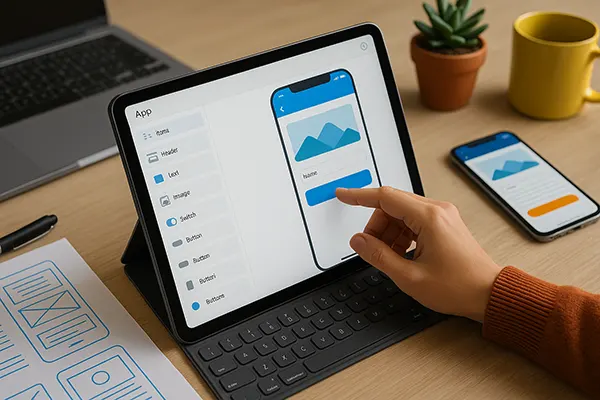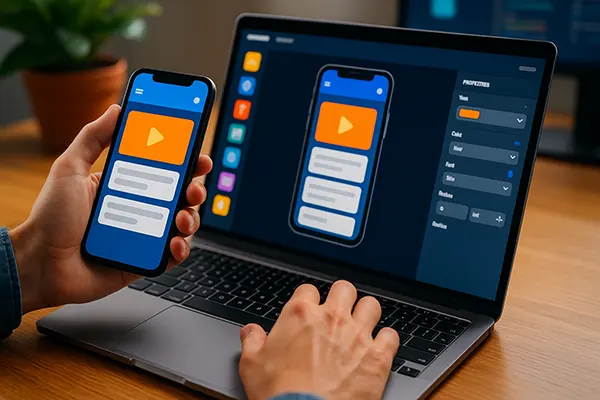
Mobile App Development Without Coding: A Beginner’s Guide
In the ever-evolving digital landscape, mobile applications have become indispensable tools for businesses and individuals alike. Traditionally, creating a mobile app required extensive programming skills, but recent advancements have made app development accessible even to those without coding expertise. No-code platforms empower users to build fully functional applications using intuitive, visual tools rather than complex programming languages. This guide explores the fundamental aspects of mobile app development without coding, offering practical advice for beginners who want to create robust applications without the need for technical knowledge.
Why Choose No-Code Mobile App Development?
No-code platforms have revolutionized the way applications are built, enabling users to create apps without writing a single line of code. Instead of complex coding processes, these platforms provide visual interfaces where users can drag and drop elements to create functional apps. This approach is not only time-efficient but also cost-effective, as it eliminates the need for hiring professional developers. Moreover, no-code development allows for rapid prototyping, which is crucial when testing new ideas or launching a minimum viable product (MVP).
One of the primary benefits of no-code development is its accessibility. Anyone with a basic understanding of design principles can create a fully functional app. These platforms come with pre-built templates, plugins, and integration options, making it simple to build complex applications without technical knowledge. Additionally, no-code tools often include features for integrating third-party services, such as payment gateways, analytics, and social media sharing, enhancing the app’s functionality.
Moreover, no-code development significantly reduces the time required to launch an app. Businesses can swiftly develop, test, and deploy applications, adapting to market demands with minimal delay. This agility is essential in today’s competitive landscape, where businesses need to respond quickly to changing customer expectations and technological trends. Furthermore, no-code platforms are continuously evolving, adding new features and improving user experience, making them a sustainable choice for long-term projects.
Popular No-Code App Development Platforms
Several platforms dominate the no-code development space, each offering unique features suited to different needs. These platforms simplify the process of building both simple and complex applications, providing a wide range of customization options. Choosing the right platform depends on your specific requirements, such as the complexity of the app, budget, and preferred operating system compatibility.
– Appgyver: Known for its comprehensive toolset, enabling the creation of both simple and complex apps. It supports both web and mobile applications and offers a robust set of features, including API integration and backend database connectivity.
– Bubble: Ideal for creating interactive web and mobile applications with extensive customization options. Bubble’s drag-and-drop editor is particularly effective for designing user-friendly interfaces and integrating with various data sources. Its ability to handle dynamic content makes it a favorite among developers looking to build apps with complex workflows.
– Thunkable: Focuses on creating mobile apps, providing native Android and iOS compatibility. Thunkable’s platform allows for real-time testing, making it easier to identify issues early. Its integration with popular APIs and straightforward publishing process make it an excellent choice for those looking to develop mobile apps without coding skills.
How to Start Building Your First App
Starting with no-code app development is easier than it may initially seem. The first step is to choose a no-code platform that aligns with your project goals. Consider factors such as user interface, integration capabilities, scalability, and pricing models. It’s essential to assess the platform’s learning curve and available resources, such as tutorials and community support, to ensure you can make the most of its features.
Once you have selected a platform, clearly outline the problem your app will solve or the service it will offer. Planning your app’s functionality in advance will save time and help maintain focus during development. After defining your idea, select a template that matches your app’s purpose. Templates can significantly reduce setup time by providing pre-configured elements and layouts.
After choosing a template, start customizing the interface using the drag-and-drop tools provided by the platform. Add essential components such as buttons, forms, media players, and navigation menus. Customize the design to reflect your brand identity, paying attention to color schemes, typography, and interactive elements. Testing your design as you build will help you identify and fix usability issues early.
Testing and Deployment
Thorough testing is crucial to ensure your app functions correctly and delivers a smooth user experience. Most no-code platforms include built-in simulators and testing environments that replicate how the app will perform on various devices. Testing on both Android and iOS platforms is recommended to catch any compatibility issues. Additionally, conducting usability testing with a small group of users can provide valuable feedback.
Once you have finalized your app, prepare it for deployment. Check for any unresolved issues and ensure that the app meets the platform’s guidelines. Some no-code platforms offer one-click publishing to app stores, while others may require additional configuration. It’s also important to create a developer account with app stores like Google Play or Apple App Store, as this will be necessary for publishing your app.
After deployment, continuously monitor your app’s performance. User feedback and analytics data can provide insights into potential improvements. Regular updates and maintenance will ensure that your app remains functional and relevant, especially when operating systems are updated or new features are introduced.

Common Challenges and How to Overcome Them
Despite their advantages, no-code platforms come with challenges. One common issue is limited customization. While templates and drag-and-drop interfaces simplify development, they may not allow for highly specific functionalities. Integrating third-party plugins or using platforms with low-code features can address these limitations.
Performance issues can also arise, especially if the app contains heavy multimedia content or complex interactions. To optimize performance, reduce image sizes, use efficient data structures, and avoid excessive use of animations. Testing the app under different network conditions can help identify areas for optimization.
Data security is another critical concern. No-code apps often rely on cloud storage, which may expose sensitive data to potential breaches. Always choose platforms that adhere to data protection regulations and offer encryption. Implementing secure user authentication methods and regularly updating security protocols will also help protect user data.
Tips for Successful No-Code App Projects
To ensure the success of your no-code app, start by setting clear objectives. Define your target audience and the core problem your app addresses. Keeping your goals aligned with user needs will make the development process more focused and efficient.
Stay proactive in testing and maintenance. Regular updates and prompt bug fixes will enhance user satisfaction and reduce potential issues. Engage users by requesting feedback and incorporating suggestions where possible.
Lastly, stay updated with platform changes and new features. As no-code development tools evolve, new functionalities may become available that could improve your app’s performance or usability. Joining community forums and following platform updates will keep your skills current.



